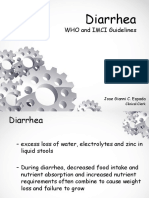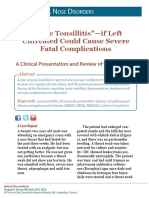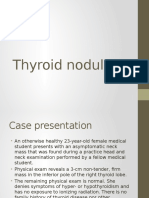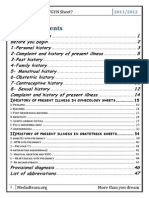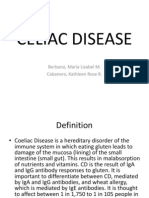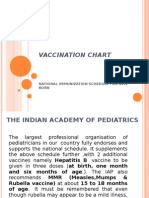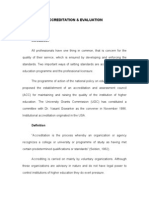Anemia Charts
Anemia Charts
Uploaded by
LizCopyright:
Available Formats
Anemia Charts
Anemia Charts
Uploaded by
LizCopyright
Available Formats
Share this document
Did you find this document useful?
Is this content inappropriate?
Copyright:
Available Formats
Anemia Charts
Anemia Charts
Uploaded by
LizCopyright:
Available Formats
Decreased hemoglobin synthesis Defective DNA synthesis in RBCs Diminished availability of erythrocyte precursors
Anemia caused by decreased Erythrocyte Production Iron-deficiency Thalassemia Sideroblastic anemia anemia Megaloblastic anemias Aplastic anemia Anemia of chronic disease
Iron-Deficiency Anemia Etiology 1. 2. 3. 4. Inadequate dietary intake. Malabsorption. Blood loss. Hemolysis Malabsorption: GI surgery: procedures that involve removal or bypass of the duodenum Malabsorption syndromes: disease of duodenum in which the absorption surface is altered or destroyed Blood loss: Major sources: GI & GU systems GI: peptic ulcer, gastritis, esophagitis, diverticuli, hemorrhoids, neoplasia. GU: primarily from menstrual bleeding Other: postmenopausal bleeding in older woman, chronic renal failure & dialysis treatment Specific clinical symptoms: 1. Pallor 2. Glossitis (inflammation of the tongue) 3. Cheilitis (inflammation of the lips) 4. Headache, paresthesisas, & burning sensation of the tongue
Clinical Manifestations
Early Course: may be free of symptoms Chronic: general manifestations of anemia
Laboratory abnormalities
Diagnostic Studies Collaborative Therapy
Hb/Hct: MCV: Reticulocytes: N or slight or Serum Iron: TIBC: Transferrin: N or Ferritin: Bilirubin: N or 1. Stool Guaiac test 2. Endoscopy & colonoscopy to detect GI bleeding 3. A bone marrow biopsy 1. Main goal: treat underlying disease that is causing reduced intake or absorption of iron (malnutrition, alcoholism). 2. Efforts toward replacing iron. 3. Teach the pt. which foods are good sources of iron (liver & muscle meats, eggs, dried fruits, legumes, whole-grain & enriched bread & cereals, potatoes). 4. If iron deficiency is from acute blood loss- the pt. may require a transfusion of packed RBCs. 5. Iron dextran, sodium ferrous gluconate, iron sucrose IM or IV (parenteral iron)
History & physical examination Hct & Hb levels, RBC count, including morphology Reticulocyte count, serum iron, ferritin, transferrin, TIBC Stool examination for occult blood Drug therapy: Five factors should be considered: 1. Iron is absorbed best from the duodenum & proximal jejunum. (Enteric-coated or sustained release capsules, release iron farther down in GI tract are counterproductive/expensive) 2. The daily dosage should provide 150 to 200 mg of elemental iron. Ingested in 3 to 4 daily doses, each tablet or capsule containing btwn 50 to 100mg of iron. 3. Iron is best absorbed as ferrous sulfate (Fe2+) in an acidic environment. Iron should be taken about an hour before meals, when the duodenal mucosa is most acidic. (Taking iron with Vitamin C (ascorbic acid) or OJ enhances iron absorption). 4. Undiluted liquid iron may stain the patients teeth; dilute it & ingest through a straw. 5. GI side effects of iron administration may occur; such as heartburn, constipation, & diarrhea. Ferrous gluconate may be used as substitute. All pts. should know stools will become black because the GI tract excretes excess iron. Constipation is common- start patient on stool softener or laxative.
Etiology
Clinical Manifestations
Lab Abnormalities
Collaborative Care
Thalassemia 1. Heterozygous has one thalassemic gene & one Group of diseases that have an autosomal normal gene- thalassemia minor recessive genetic basis involving 2. Homozygous person has two thalassemic genesinadequate production of normal thalassemia major hemoglobin Due to absent or reduced globulin protein Abnormal Hb synthesis Thalassemia major: Both physical & mental growth retarded Pale & other general symptoms that devlop in childhood by 2 years of age Pronounced splenomegaly & hepatomegaly Jaundice from RBC hemolysis Chronic bone marrow hyperplasia & expansion of marrow space Thickening of cranium & maxillary cavity Hb/Hct: MCV: N or Reticulocytes: Serum Iron: TIBC: Transferrn: Ferritin: Bilirubin: Thalassemia minor: requires no treatment Thalassemia major: because the body adapts to the reduction of Symptoms are managed with blood transfusions or normal hemoglobin exchange transfusions in conjunction with oral deferasirox (Exjade) or IV or subcutaneous Hep C may result in cirrhosis & hepatocellular deferoxamine (Desferal) carcinoma Folic acid is given if there is sign of hemolysis Zinc may be needed (reduced with chelating Cardiac complications from iron overload, therapy) as well as ascorbic acid during chelation pulmonary disease, & hypertension early therapy (increases the excretion of iron) death Iron supplements should not be given Splenectomy Hepatic, cardiac, & pulmonary organ function Hep C is present in most patients older than 25 should be monitored years- because of receiving blood transfusions before they were screen for hep C Endocrinopathies (hypogonadotrophic hypogonadism) & thrombosis complications Hematopoietic stem cell transplantation remains the only cure- risk outweigh the benefits
Megaloblastic Anemias: Caused by impaired DNA synthesis Presence of large RBCs Result from cobalamin (vitamin B12) & folic acid deficiencies Other: drug-induced suppression of DNA synthesis, inborn errors, & erythroleukemia Cobalamin (Vitamin B12) Deficiency GI surgery: Long-term users of Most common cause H2-histamine is pernicious Gastrectomy, gastric receptor blockers anemia: a disease in bypass which the gastric Patients who have had a & proton pump inhibitors, & mucosa is not small bowel resection vegetarians secreting IF because involving the ileum of antibodies being Crohns disease, ileitis, directed against the celiac disease, gastric parietal cells diverticuli of the small and/or IF itself intestine, chronic atrophic gastritis Deficiency is the result from loss of IF-secreting gastric mucosal cells or impaired absorption of cobalamin in the distal ileum.
Etiology
Pernicious anemia: caused by the absence of IF- from either gastric mucosal atrophy or autoimmune destruction of parietal cells
Clinical Manifestations:
Diagnostic Studies:
Collaborative Care:
GI: Sore, red, beefy, & shiny tongue Anorexia, nausea, & vomiting Abdominal pain Neuromuscular: Weakness, paresthesias of feet & hands Reduced vibratory & position senses Ataxia Muscle weakness Impaired thought processes ranging from confusion to dementia Hb/Hct: If serum cobalamin levels are low & folate levels are normal cobalamin MCV: deficiency. Reticulocytes: N or A serum test for anti-IF antibodies may be done = specific for pernicious Serum Iron: anemia. TIBC: N Schilling test- radioactive cobalamin is administered to patient- absorption of Transferrn: cobalamin when IF is added is diagnostic of pernicious anemia Ferritin: MMA- elevated in cobalamin Bilirubin: Pt should be instructed High-dose oral cobalamin & sublingual cobalamin are available for those in on adequate dietary whom GI absorption is intact intake to maintain good nutrition Parenteral or intranasal administration of cobalamin is the treatment of choice
Etiology
Clinical Manifestations:
Collaborative Care
Folic Acid Deficiency Dietary deficiency Malabsorption syndromes Drugs interfering with absorption/use of folic acid- Methotrexate & Antiseizure drugs Alcohol abuse Anorexia Hemodialysis patients Disease develops insidiously Symptoms may be attributed to other coexisting problems such as cirrhosis or esophageal varices GI: Dyspepsia Smooth, beefy red tongue The absence of neurologic problems Treated with replacement therapy Ensure that injuries are not sustained because of the Usual dose is 1 mg per day by mouth diminished sensations to heat & pain resulting from the Patient should be encourage to eat neurologic impairment foods containing large amounts of folic Protect the patient from falling, burns, & trauma acid
Anemia of Chronic Disease (anemia of inflammation) Underproduction of RBCs Mild shortening of RBC survival RBCs are usually normocytic, normochromic, & hypoproliferative Immune driven Cytokines released by these conditions cause an increased uptake & retention of iron within macrophages Ex: Renal disease: the primary factor causing anemia is decreased erythropoietin (hormone made in the kidneys that stimulates erythropoiesis) Myelosuppression & decreased erythropoiesis caused by disease, medications (chemotherapy), or radiation will contribute to normochromic, normocytic anemia HIV & its treatments, hepatitis, malaria, & bleeding episodes contribute to this anemia Hypopituitary & hypothyroid Adrenal dysfunction caused by either adrenalectomy or Addisons disease Differentiated from anemias of other etiologies: Elevated serum ferritin & increased iron stores distinguish it from iron-deficiency Normal folate & cobalamin blood levels Erythropoietin therapy (Epogen, darbepoetin) is used for anemia related to renal disease
Etiology:
Pt. has peripheral blood pancytopenia ( of all blood cell types- RBCs, WBCs, platelet) & hypocellular bone marrow
Clinical Manifestations:
Abruptly (over days) or insidiously over wks to months Can vary in mild to severe Manifestation: fatigue & dyspnea Cardiovascular & cerebral responses
Aplastic Anemia Two major Congenital Acquired: groups: (Chromosomal Idiopathic/autoimmune 1. Congenital alterations): Chemical agents & toxins (benzene, 2. Acquired Fanconi syndrome insecticides, arsenic, alcohol) (70% are Congenital Drugs (alkylating agents, idiopathic dyskeratosis antiseizure drugs, antimetabolites, & thought antimicrobials, gold) Amegakaryocytic to be thrombocytopenia Radiation autoimmu Schwachman Viral & bacterial infections ne) Diamond (hepatitis, parvovirus) syndrome Pt with neutropenia (low neutrophil count) is susceptible to infection & is at risk for septic shock & death Even a low grade fever (above 100.4F) should be considered an emergency Thrombocytopenia is manifested by a predisposition to bleeding (petechiae, ecchymosis, epistaxis)
Diagnostic Studies: Collaborative Care:
Hemoglobin, WBC, & platelet values are decreased Marrow is hypocellular with increased yellow marrow (fat content) Identifying the HSCT and ATG causative Cyclosporine or high-dose cyclophosphamide (Cytoxan) agent & ATG- horse serum that contains polyclonal antibodies against human T cells providing supportive care until the pancytopenia reverses Prevent complications from infection & hemorrhage
Etiology:
Clinical Manifestations:
Collaborative Care:
Acute Blood Loss: Anemia 1. Sudden reduction in the total blood volume that can Result of sudden lead to hypovolemic shock hemorrhage 2. If the acute blood loss is more gradual the body Causes: trauma, maintains its blood volume by slowly increasing the complications in surgery, plasma volume & conditions or diseases that disrupt vascular integrity Volume Lost (%) 10% - none 20%- no detectable signs or symptoms at rest, tachycardia with exercise & slight postural hypotension 30%- Normal supine blood pressure & pulse at rest, postural hypotension & tachycardia with exercise. 40% - blood pressure, central venous pressure, & cardiac output below normal at rest; rapid, thread pulse & cold, clammy skin 50%- shock & potential death 1. Replacing blood volume to prevent For postoperative patient: shock Monitor the blood loss from various 2. Identifying the source of the drainage tubes & dressings & hemorrhage & stopping the blood loss. implement appropriate actions (IV fluids used in emergencies include Administration of blood products dextran, hetastarch, albumin, and/or crystalloid electrolyte solutions such as lactated Ringers solution. 3. Correcting the RBC loss- body needs 2 to 5 days to manufacture more RBCs in response to increased erythropoietin. 4. Supplemental iron
Etiology: (similar to those of irondeficiency anemia)
Chronic Blood Loss: Anemia Sources: Effects: Bleeding ulcers Depletion of iron stores & considered Hemorrhoids as iron-deficiency Menstrual & anemia postmenopausal blood loss
Management: identifying the source & stopping the bleeding
You might also like
- Travel AssignmentDocument19 pagesTravel AssignmentAashish Jha0% (1)
- Pat 2 Medsurg1Document20 pagesPat 2 Medsurg1api-300849832No ratings yet
- CholestyramineDocument1 pageCholestyramineKatie McPeekNo ratings yet
- Flyers Reading and Writing Test 4 PDFDocument12 pagesFlyers Reading and Writing Test 4 PDFSorin Sotoc100% (1)
- Antihyperglycemic Agents Comparison ChartDocument9 pagesAntihyperglycemic Agents Comparison ChartBonnieNo ratings yet
- Pedia PPT1Document52 pagesPedia PPT1Jan Mikhail FrascoNo ratings yet
- Abdominal MassDocument7 pagesAbdominal MassRoseben SomidoNo ratings yet
- Medical History Outline-2020Document9 pagesMedical History Outline-2020sumiti_kumarNo ratings yet
- ALT (Alanine Aminotransferase) Test - Purpose, Procedure, and Results PDFDocument5 pagesALT (Alanine Aminotransferase) Test - Purpose, Procedure, and Results PDFMARIUS BACIUNo ratings yet
- Guide To Assessment and Management of Acute Gastroenteritis in Primary CareDocument2 pagesGuide To Assessment and Management of Acute Gastroenteritis in Primary CareMaya LarasNo ratings yet
- Thalassemia Case StudyDocument13 pagesThalassemia Case StudyNellyWataNo ratings yet
- Diabetic Gastroparesis: Pathophysiology, Evaluation and ManagementDocument10 pagesDiabetic Gastroparesis: Pathophysiology, Evaluation and ManagementboomNo ratings yet
- Seizure Disorders in ChildrenDocument22 pagesSeizure Disorders in ChildrenBheru LalNo ratings yet
- Interview QuestionsDocument4 pagesInterview QuestionsJilian McGuganNo ratings yet
- Benign Diseases of ThyroidDocument70 pagesBenign Diseases of ThyroidMounica MekalaNo ratings yet
- How Phototherapy WorksDocument4 pagesHow Phototherapy WorksmaramNo ratings yet
- Case 7 ResultsDocument14 pagesCase 7 ResultsRegia putri ellandaNo ratings yet
- Case Scenerio MENINGITISDocument10 pagesCase Scenerio MENINGITISEllen AngelNo ratings yet
- Hematology: FANER, Ned Denebe LACANILAO, Sunshine NUCUM, Billie Kim PAGADUAN, Maribec PUA, MonalisaDocument31 pagesHematology: FANER, Ned Denebe LACANILAO, Sunshine NUCUM, Billie Kim PAGADUAN, Maribec PUA, MonalisatzuquinoNo ratings yet
- Mature CataractDocument24 pagesMature CataractmethadamayNo ratings yet
- Case 2 and 3 Q1Document3 pagesCase 2 and 3 Q1Jeffrey Ramos0% (1)
- Diarrhea: WHO and IMCI GuidelinesDocument37 pagesDiarrhea: WHO and IMCI GuidelinesJohn Christopher Luces100% (1)
- Diabetes Mellitus in PediatricsDocument22 pagesDiabetes Mellitus in PediatricsKermaigne MirandaNo ratings yet
- History and Physical ExaminationDocument17 pagesHistory and Physical ExaminationNur Fatima SanaaniNo ratings yet
- HPN Drug StudyDocument4 pagesHPN Drug StudyJohn Haider Colorado GamolNo ratings yet
- Acute TonsillitisDocument7 pagesAcute TonsillitisMichael HostiadiNo ratings yet
- Acute Pyelonephritis in Adults Rapid Evidence Review PDFDocument8 pagesAcute Pyelonephritis in Adults Rapid Evidence Review PDFMari aNo ratings yet
- Page 35-52 (Drug Study Gyne)Document20 pagesPage 35-52 (Drug Study Gyne)Ivan Chester de GuzmanNo ratings yet
- JaundiceDocument22 pagesJaundiceimanzurynn161No ratings yet
- Nodul Tiroidian Engleza PPT 2016Document36 pagesNodul Tiroidian Engleza PPT 2016Stefi GrNo ratings yet
- Malabsorption Syndrome: Dr. Md. Golam Kibria Khan Associate Professor of Medicine Medicine Unit - Iv MMCHDocument20 pagesMalabsorption Syndrome: Dr. Md. Golam Kibria Khan Associate Professor of Medicine Medicine Unit - Iv MMCHThunder BoltNo ratings yet
- Anatomy and PhysiologyDocument5 pagesAnatomy and Physiologyjohn michael100% (1)
- Ovarian Hyperstimulation Syndrome Diagnosis and ManagementDocument21 pagesOvarian Hyperstimulation Syndrome Diagnosis and ManagementNur AnindyaNo ratings yet
- Case Report Non-infection Unit Β-Major ThalassemiaDocument27 pagesCase Report Non-infection Unit Β-Major ThalassemiaimamkdNo ratings yet
- Failure To ThriveDocument2 pagesFailure To Thrivekafosid100% (1)
- Shock PresentationDocument20 pagesShock Presentationrosalyn sugayNo ratings yet
- 494x Celiac Powerpoint MB RevDocument21 pages494x Celiac Powerpoint MB Revkhalito1991No ratings yet
- Case Presentation STEMIDocument35 pagesCase Presentation STEMIFitriya Syaifuddin100% (1)
- AtaxiaDocument8 pagesAtaxiaDivya Gupta0% (1)
- Drug StudyDocument10 pagesDrug StudyFranco ObedozaNo ratings yet
- Pharma GI CardsDocument16 pagesPharma GI CardsDoctorsHangout.comNo ratings yet
- Acute Intracranial Hemmorhage Case StudyDocument58 pagesAcute Intracranial Hemmorhage Case StudyMark Tristan AsuncionNo ratings yet
- Case 1 Pedia Henoch Schonlein PurpuraDocument45 pagesCase 1 Pedia Henoch Schonlein PurpuraJefferson Gumiran100% (1)
- Medad How To Write An OBGYN SheetDocument47 pagesMedad How To Write An OBGYN SheethemazzzzNo ratings yet
- Appendicitis Case StudyDocument2 pagesAppendicitis Case StudyLeviThomasStafford100% (1)
- 08&09 Oral Hypoglycemics-Level 11Document48 pages08&09 Oral Hypoglycemics-Level 11Usman Ali AkbarNo ratings yet
- A Case Study On AsthmaDocument38 pagesA Case Study On AsthmaMark Tristan AsuncionNo ratings yet
- AnemiaDocument10 pagesAnemiaBia Payawal100% (2)
- Drug Study (Capitol)Document8 pagesDrug Study (Capitol)Joy CalmerinNo ratings yet
- GE BasavaDocument21 pagesGE BasavaAmalin PrãdhãñNo ratings yet
- Morning Report: Jawaria K. Alam, MD/PGY3Document20 pagesMorning Report: Jawaria K. Alam, MD/PGY3Emily EresumaNo ratings yet
- Celiac DiseaseDocument15 pagesCeliac DiseaseMarty AsisNo ratings yet
- AcetaminophenDocument2 pagesAcetaminophendrugcardref100% (1)
- NSTEMIDocument33 pagesNSTEMIwaazalimahwahidNo ratings yet
- Esophageal VaricesDocument4 pagesEsophageal VaricesSnapeSnapeNo ratings yet
- Antiphospholipid Antibody SyndromeDocument37 pagesAntiphospholipid Antibody SyndromeAhmad Reshad AslamNo ratings yet
- A Case Study Of: Hypertension Emergency, Hypertensive Cardiovascular DiseaseDocument23 pagesA Case Study Of: Hypertension Emergency, Hypertensive Cardiovascular DiseaseKristine AlejandroNo ratings yet
- Vaccination Chart: National Immunization Schedule For New BornDocument20 pagesVaccination Chart: National Immunization Schedule For New BornsmilealwplzNo ratings yet
- Brain AbscessDocument2 pagesBrain AbscessIan RomanNo ratings yet
- Ventricular Septal Defect, A Simple Guide To The Condition, Treatment And Related ConditionsFrom EverandVentricular Septal Defect, A Simple Guide To The Condition, Treatment And Related ConditionsNo ratings yet
- Cyanosis, A Simple Guide To The Condition, Diagnosis, Treatment And Related ConditionsFrom EverandCyanosis, A Simple Guide To The Condition, Diagnosis, Treatment And Related ConditionsRating: 5 out of 5 stars5/5 (1)
- Problem-based Approach to Gastroenterology and HepatologyFrom EverandProblem-based Approach to Gastroenterology and HepatologyJohn N. PlevrisNo ratings yet
- Annelida PresentationDocument20 pagesAnnelida PresentationtariNo ratings yet
- AccreditationDocument35 pagesAccreditationSatish PatilNo ratings yet
- INTRODUCTIONDocument2 pagesINTRODUCTIONEldonVinceIsidroNo ratings yet
- Eiffel Eye Clinic - Google SearchDocument1 pageEiffel Eye Clinic - Google SearchMudassir AllooNo ratings yet
- Ethnicity in India PDFDocument2 pagesEthnicity in India PDFAustinNo ratings yet
- Manuel de L'Opérateur WL32Document272 pagesManuel de L'Opérateur WL32pierre ThibodeauNo ratings yet
- Rabbits ThesisDocument6 pagesRabbits Thesisiinlutvff100% (2)
- Chapter IiDocument23 pagesChapter IiHendra Co'olihieenNo ratings yet
- Institute of Business Administration, Karachi: Step-By-Step Assignment InstructionsDocument4 pagesInstitute of Business Administration, Karachi: Step-By-Step Assignment InstructionsMaha Siddiqui100% (2)
- English 7 Q1 Quiz 2Document2 pagesEnglish 7 Q1 Quiz 2Angelica JessaNo ratings yet
- Prudentia Monsoon Mania 2021 (Competition Categories)Document2 pagesPrudentia Monsoon Mania 2021 (Competition Categories)prii_jazzNo ratings yet
- Non Compliance ApplicationDocument10 pagesNon Compliance ApplicationRAJARAJESHWARI M GNo ratings yet
- 8.chapter 3 - Have Business Leaders Define What's Possible - RewiredDocument10 pages8.chapter 3 - Have Business Leaders Define What's Possible - RewiredZaghim GhafoorNo ratings yet
- Alpha Charger c25Document24 pagesAlpha Charger c25Muhammad SyukurNo ratings yet
- Lesson 7 - Sexual BehaviorsDocument10 pagesLesson 7 - Sexual BehaviorsApril CaringalNo ratings yet
- Practical Exercises Raúl CarballoDocument9 pagesPractical Exercises Raúl CarballoAlfonso MartínezNo ratings yet
- 2 Models of SuzukiDocument15 pages2 Models of SuzukishhanoorNo ratings yet
- ENGLISH LANGUAGE TEST (MESSAGES1-third Trimester Test) B Student's Full Name - ClassDocument3 pagesENGLISH LANGUAGE TEST (MESSAGES1-third Trimester Test) B Student's Full Name - ClassBiljana PetrovskaNo ratings yet
- Nasi ISpani Booklet (16 June 2023)Document92 pagesNasi ISpani Booklet (16 June 2023)Belinda EloffNo ratings yet
- Unit 11 Research Project - LO1 ExampleDocument8 pagesUnit 11 Research Project - LO1 ExampleAsif Abdullah KhanNo ratings yet
- Carlos vs. AngelesDocument2 pagesCarlos vs. AngelesHanamichi Sakuragi Goku San0% (1)
- Retained EarningsDocument4 pagesRetained EarningsHaru Haru100% (1)
- Management Accounting Notes at Mba BKDocument134 pagesManagement Accounting Notes at Mba BKBabasab Patil (Karrisatte)No ratings yet
- 30JAN18 LA PER 18 2206 CEDINCO Cooperation Agreement EnglishDocument12 pages30JAN18 LA PER 18 2206 CEDINCO Cooperation Agreement EnglishGUIDO DARI QUISPE ROJASNo ratings yet
- United States v. Patricia Dawn Glosson, United States of America v. Jonathan Idema, United States of America v. Jonathan Idema, United States of America v. Jonathan Idema, United States of America v. Jonathan Idema, United States of America v. Jonathan Idema, United States of America v. Jonathan Idema, United States of America v. Jonathan Idema, United States of America v. Jonathan Idema, 83 F.3d 416, 4th Cir. (1996)Document4 pagesUnited States v. Patricia Dawn Glosson, United States of America v. Jonathan Idema, United States of America v. Jonathan Idema, United States of America v. Jonathan Idema, United States of America v. Jonathan Idema, United States of America v. Jonathan Idema, United States of America v. Jonathan Idema, United States of America v. Jonathan Idema, United States of America v. Jonathan Idema, 83 F.3d 416, 4th Cir. (1996)Scribd Government DocsNo ratings yet
- Testing Interview QuestionsDocument87 pagesTesting Interview QuestionsNimisha8730No ratings yet
- Nondeterministic Finite Automata (NFA) : Multiple Next StateDocument4 pagesNondeterministic Finite Automata (NFA) : Multiple Next StateSoumodip ChakrabortyNo ratings yet
- Farmers Dreams Walkthrough 2Document13 pagesFarmers Dreams Walkthrough 2FarhadFaisal0% (1)





















